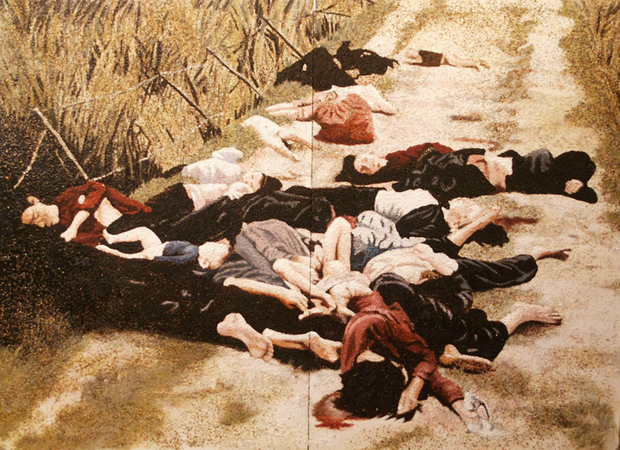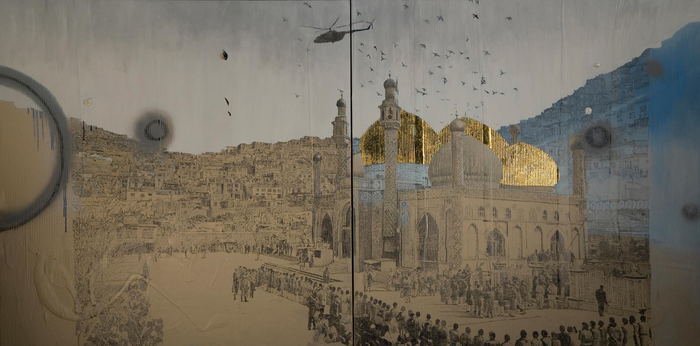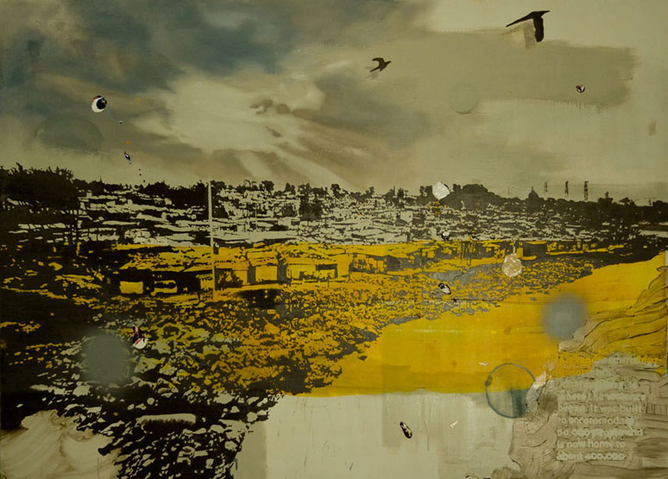Images and their agency
We need to grasp both sides of the paradox of the image: that it is alive but also dead; powerful but also weak; meaningful but also meaningless. (wjt Mitchell, what do pictures want)
Framing
In this text I would like to grasp the paradox of the image, as Mitchell urges, and consider its aliveness and its deadness. I will not be making an objective case for the sentience of the image but considering from a phenomenological perspective how do we experience their power and weakness, their meaning and meaninglessness how do we experience their agency. I intend to do this by focusing on a group of paintings I have made since 2004; I want to enquire into the capacity of these works to address the agency of the image and how it is felt or experienced.
Since 2004 when I painted Pinkville (The My Lai massacre) I have periodically collected and painted images from the media that depict conflict or the lived conditions resulting from conflict. Other than Pinkville, these are not direct depictions of conflict but rather of struggle struggle that follows inequality for which we as viewers might collectively share in responsibility. This responsibility may be several steps removed but our choices of how we live with them are contingent on this inequality.
While each painting addresses the viewer through the representation of a particular event or even narrative, together with it’s materiality and formal language, what I am primarily concerned with here is a common ontological or moral proposition they as a group of paintings pose. This proposition of the image is the focus of my enquiry.
I would like to frame the enquiry into the agency or proposition of this group of painting through three primary sets of ideas or questions. My intention here is to offer three perspectives on the work rather than provide a singular reading. The commonality of these three perspectives lies in the distinctive ways in which the agency of the image is experienced.
Image
The first perspective concerns how we live with the image and its agency? My question here, prompted by the work itself, concerns the ethical implications following an encounter with the image. The image encounter I am interested in can be usefully explored through Badiou’s ideas on the truth process following what he calls an event.
For me, an event is something that brings to light a possibility that was invisible or even unthinkable. An event is not by itself the creation of reality; it is the creation of a possibility, it opens up possibility. The event is, in a certain way, merely a proposition. Everything will depend on the way in which the possibility proposed by the event is grasped, elaborated, incorporated and set out in the world. This is what I name a truth procedure. (Badiou 2013, p.9)
These ideas are explored in his book Ethics An Essay on the Understanding of Evil (Badiou, 2002), but which I first encountered in Ine Gevers essay Images that Demand Consummation (documentary now 2005) Badiou is interested in exploring the process or event by which a subject is further constituted by way of a truth procedure or as I would see it how is an encounter with the image ontologically determining. For Badiou what is critical to the event that prompts an individual truth procedure, is how the individual keeps faith with that event. How the event ruptures given knowledge and transfigures it. In so doing subject is created, and consequently able to imagine possibilities beyond previously held conventions.
Badiou is not interested in socially determining codes of ethics but an individually driven form of ethics that is centered on the event; an event in which the subject must actively negotiate a position that holds to that event or keeps faith with it.
This is a compelling picture of how we might live with the image and its agency. According to Badiou, the creative process of the artist typifies the truth process and is therefore intrinsically linked to his understanding of ethics. After all aesthetics originated as an attempt to understand the ethics of perception.
A painting then can be understood as an autonomous zone in which not only the artist but also the viewer is able to ethically encounter the image and follow an individual truth procedure ñ negotiate a truth to living with the image in becoming subject. The capacity for the painting to instigate a truth procedure in the viewer is contingent on the degree of successful transfiguration of the image.
Body
The second perspective concerns the importance of the material surface or body of the painting. My question here arose again out of the work and was developed during my practice driven PhD research, in which the importance of an embodied experience in relation to painting was explored. Through the material composition of the paintings surface stones, varnish, scraped masonry paint, manual marks that convey the hand that made them - I have always been intent on perceptually reminding the viewer that they are stood in front of a painting, which only describes pictorial space. I was reminded of the importance of this recently when I discovered the story of a woman named Sara Chesterman who had lost surface skin sensation on 90% of her body, in a book by J. Bennett Empathic vision: affect, trauma, and contemporary art. (Bennett J. 2005).
Chesterman states you need to feel to see images, in particular you need to feel to know that what is visibly occurring before you is not actually happening to your own body (Bennett J. 2005.). Ordinarily we as the viewers of images remind ourselves of our physicality by touching ourselves and in the case of extreme images harrowing photo-journalism, horror films for example we have a squirm reflex (galvanic skin response). This physical response to the image has two important functions. Firstly it is to recoil from the affect of the image, to remind ourselves that we are viewing a representation of something that is not occurring in the present and to our body. Secondly the physical response, because it locates the depicted experience in the present, enabling us to feel the image as an embodied experience. This response augments our experience between a representational mode of viewing and a sensory or embodied mode of viewing.
Skin then is a permeable image barrier that augments the agency of the image. It protects us from the intensity of the image’s affect as sensation and directs us to the representational, while also enabling us to meet and sense, on our own terms, according to the body the affect of the image. Without the permeable barrier of the skin, as in the case of Chesterman, we are at the mercy of the cyclopic vision of the lens or the screen: a prehistoric dream space of terror or indifference. In Dialectic Of Enlightenment Adorno and Horkheimer explore the idea of the Cyclops as representing the mythological dreamtime of the titans that I equate with single lens generated images of photography and film. They lack the objectivity of the stereoscopic perspective of the eyes. The Cyclops Polyphemus, bears his cartwheel-sized eye as a trace of the same (Lotus eaters) prehistoric world: the single eye recalls the nose and the mouth, more primitive than the symmetry of eyes and ears, which, with the security guaranteed by two unified perceptions, is the virtual prerequisite of identification, depth, and objectivity. Nevertheless, in comparison with the Lotus-eaters, Polyphemus represents a later stage in world development the barbaric age proper, one of hunters and herdsmen.(Adorno T. and Horkheimer M, 1979 p.64
In the interior dream space of the lens, we are possessed by the image. Without our body in the exterior world, the affect of the image either situates us at the heart of an archetypal narrative or the narrative is fractured and the representational fragments stripped of affect, wash over us. Either way, without our skin and the embodied experience that enables a proper encounter with the image, we are incapable of negotiating the agency of the image.
Again the painting can be understood as an autonomous zone, where equivalence exists between the skin and body of the viewer and that of the painting. The painting invites us to explore and consider the perceptual threshold between our interiority and the exteriority of the world. This interiority and exteriority is interestingly explored in Merleau-Ponty’s articulation of the reversibility of subject and object or ‘flesh’.
Flesh
The third perspective concerns the passage of images between interior and exterior space and how this process is mutually determining. My question here concerns how painting is able to make visible this exchange as a kind of extension to perception. Merleau-Ponty’s phenomenological insights into the function of image in this exchange of subject and object has been formative to my understanding of painting. The following extracts are from his text Eye and Mind.
There is a human body when, between the seeing and the seen, between touching and the touched, between one eye and the other, between hand and hand, a blending of some sort takes place – when the spark is lit between sensing and sensible, lighting the fire that will not stop burning until some accident of the body will undo what no accident would have sufficed to do… (Merleau-Ponty M in Johnson, G.A. (1993), p.125)
This is Merleau-Ponty’s picture of flesh, which is the blending of subject and object – the reflexive relation of self and world. The squirm reflex discussed earlier interestingly describes this state of being between hand and hand, between sensing and sensible.
Merleau-Ponty describes the body as being “caught in the fabric of the world, things are an annex or prolongation of itself, they are incrusted into its flesh”. (Merleau Ponty M in Johnson, G.A. (1993) p.125)
We understand the world according to our body as being constituted of the same stuff. The vital point here is that the porous relation between self and world is the site of visual perception. Merleau-Ponty suggests there is a reversal or exchange of object and subject in sight that necessitates a reversal of the process of apprehension. It is not simply that we apprehend the world as an autonomous subject, but that we, as object, facilitate the world in it’s becoming. These enigmatic exchanges between body and world are integral to the artist’s project. They are central to the process of perception and the process of painting. Merleau-Ponty says of this dynamic between the body and the world, “Things have an internal equivalent in me; they arouse in me a carnal formula of their presence. This is a carnal essence or icon of the first.” (Merleau-Ponty M in Johnson, A.G. (1993), p.126) This last statement indicates that images, their generation and subsequent exchange, are innate to our being OF the world. They are also fundamental to our status as being OF the world, as is to turn that world and by extension ourselves into pictures.
Synthesis
These three perspectives on the agency of image and how it might be experienced form a very specific and particular framing of my painting practice. More precisely, it provides a framework to explore the concerns of a group of paintings that might be understood as having a moral proposition and by extension an ethical or political proposition. Following Merleau-Ponty’s assertion that we are OF the world, this fact renders us as viewers complicit in the represented inequality of the images. Not only in the sense that we belong to a capitalist society that is responsible for much inequality in our name but perhaps more importantly that we use images for morally questionable ends – to feel something, to stimulate sensory responses for their own sake. Here in lies the political proposition.
There exists a ‘break’ between viewer and event that the image at once traverses and compounds. The image traverses the break in the sense that we are transported in space and time to the event; and it compounds in the sense that we are insulated from the time and place of the event. This break is further pronounced in the case of the represented individuals, where the agency of the image is felt but not that of the individual pictured. A temporal break exists and is compounded in body but traversed in imagination.
The scope of our political response is therefore limited in the absence or in the highly controlled nature of any political activity outside of parliamentary democracy. Our response then is predominantly individual rather than group – personal rather than political. However, not to respond, according to Badiou, is to be complicit.
“We have to rid ourselves of the idea that the main contradiction is that between civilized and barbarians. We have to escape from consensus. This means that everyone agrees with the evaluation that society is not going to change. Capitalism in the economy and parliamentary democracy in politics is, basically, a really good combination – that’s what consensus maintains”. (Badiou, 2013 p.3)
Our sense of consensus in the face of images of inequality leaves us as viewers in a state of challenged inaction. Our response is limited to further consensus and inaction or to accept the insistence of the image in following a truth procedure that results in new possibilities that are grasped, elaborated, incorporated and set out in the world. The paintings evidence this process and are an autonomous zone in which the viewer is able to think through this according to the body. How the individual paintings do this can only be understood fully by a viewer standing in front of the work and the subsequent life the works takes on following this event.
Badiou, A with Tarby, F. Philosophy and the Event, Malden, Polity Press, 2013
Bennett, J. Empathic Vision: Affect, Trauma, and Contemporary Art, (2005) Stanford, Calif. : Stanford University Press,
Johnson, G.A. The Merleau-Ponty Aesthetic Reader, Philosophy and Painting. (1993) North Western University Press, Illinois.
Mitchell, W.J.T What do pictures want: The Lives And Loves Of Images, (2005) University of Chicago Press, London





